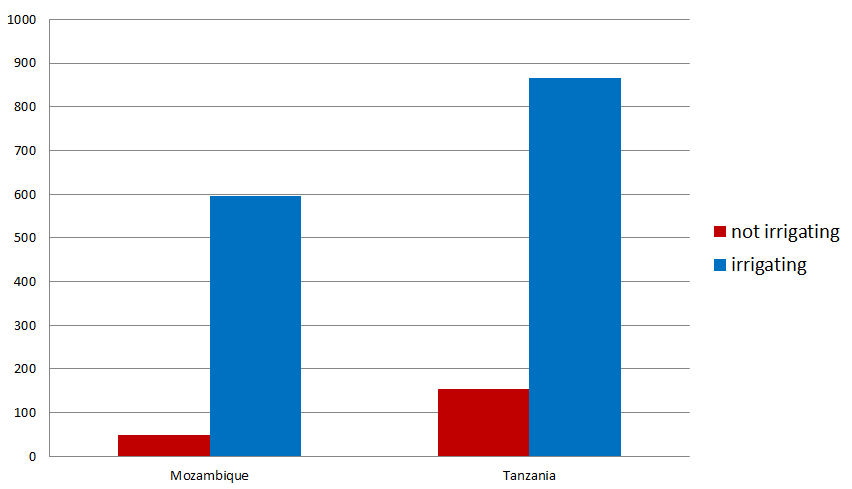Average gross crop sales: USD/household per year
In Mozambique, farmers who irrigated received, on average, 12 times more in crop sales than farmers without irrigation. In Tanzania, farmers using irrigation saw an increase of five times.
Did irrigation make a difference to the wider economy?
The SAFI project demonstrated that irrigating households generated USD 35-69 million from additional crop sales relative to non-irrigating households in Rukwa region alone. Rukwa accounts for just 3.3% of the Tanzanian population and a tiny proportion of its irrigated land. This is many times more than the USD 2.2 million allocated annually to irrigation in the national budget.
The money irrigated farming in Rukwa generates is equivalent to 20 – 40% of the annual average of USD 188 million of donor funding proposed in Tanzania’s 5-year budget for Sustainable Water and Land Management Fund (which allocates 85% for irrigation) in the government’s Agricultural Sector Development Programme II.
Additional data sources
Official data are only collected through government surveys and these may be run at intervals of 3 to 5 years, which makes it difficult to accurately track the expansion and total area of irrigated land. The SAFI project undertook a pilot study to investigate if satellite data could be used to estimate the area of irrigated land.
Methodology
Radar signals transmitted from satellites onto the earth’s surface give a reflected signal that is characteristic of particular types of vegetation and soil moisture. These reflected signals can be collected by the satellite irrespective of daylight or cloud cover. By collecting repeated signals over the growing season, a ‘signature’ of different types of vegetation growth can be identified.
Using the geographical coordinates of known irrigation sites, an algorithm can be constructed for the radar signal of irrigated fields. This can then be used to assess how widespread that signature is across a region and subsequently allows an assessment of the area of irrigated fields.
The SAFI pilot study was able to use this approach to analyse radar data collected at 12-day intervals by the European Space Agency’s Sentinel-1 satellite to assess the extent of paddy rice across three regions in Tanzania.
The pilot study suggested that official statistics may seriously underestimate the expansion of irrigated areas. In the rice-producing region of Shinyanga, for example, the most recent agricultural census in 2007-08 recorded just under 30,000 hectares of irrigation. Nine years later in 2016-17, the reflected radar images, suggested paddy rice fields created by farmers cover approximately 250,000 hectares, or between 8 and 10 times more. Similarly, in the Rukwa region, radar image analysis suggested irrigated areas are between 3 to 6 times larger than recorded in the 2007-08 census.
The pilot study showed that ‘training’ the algorithm to identify a reflected radar signature for paddy rice meant it was less successful at identifying other kinds of irrigation (e.g. for tree crops) and new algorithms would have to be developed for these.
The large areas of irrigation identified in the pilot study indicate that the value of agricultural output from farmer-led irrigation development is significant. For example, the value of paddy rice produced in Shinyanga Region can be estimated at about USD 155 million, of which at least USD 80 million is likely to be sold (assuming the official average yield of 2.5 tons per hectare and a price of USD 250/ton). The significance of this cash flow in the agricultural economy can be assessed relative to investments made informal irrigation.
Watch a lecture by Professor Phil Woodhouse outlining the SAFI project
Key Messages
|
Suggested further reading:
Acknowledgements:
- Chris de Bont, Stockholm University, Sweden
- Hans Komakech, Nelson Mandela Institution of Science and Technology, Tanzania
- Angela Manjichi, Instituto Superior Politécnico de Manica (ISPM), Mozambique
- Phil Woodhouse, Global Development Institute, The University of Manchester
